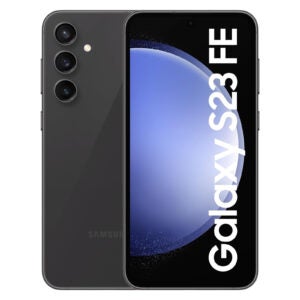Recent iPhone and iPad models will soon be completely controllable by the user’s eyes and could potentially cure motion sickness, Apple has announced today.
The latter new accessibility feature, expected to arrrive in iOS 18 later this year, will help people who experience motion sickness use their phone or tablet in a moving vehicle.

Get a Samsung Galaxy S23 FE for an A-Series price
When you sign up for a n0-commitment data contract with Voxi you can get the popular Samsung Galaxy S23 FE for just £450 – a £149 saving.
It’s called Vehicle Motion Cues and will place animated dots on the display to represent the motion of the vehicle. Apple says it’ll reduce sensory conflict caused by the car moving and the screen staying still.
“Research shows that motion sickness is commonly caused by a sensory conflict between what a person sees and what they feel, which can prevent some users from comfortably using iPhone or iPad while riding in a moving vehicle,” Apple says.
“With Vehicle Motion Cues, animated dots on the edges of the screen represent changes in vehicle motion to help reduce sensory conflict without interfering with the main content. Using sensors built into iPhone and iPad, Vehicle Motion Cues recognizes when a user is in a moving vehicle and responds accordingly.”


The Eye Tracking feature (pictured in the main image) is one of a number of new accessibility features designed for Apple fans with physical disabilities. It uses artificial intelligence and the front facing camera to enable users to move through the user interface.
“With Eye Tracking, users can navigate through the elements of an app and use Dwell Control to activate each element, accessing additional functions such as physical buttons, swipes, and other gestures solely with their eyes,” Apple says in a Newsroom post today.
Apple says it works across the suite of iOS and iPadOS apps and doesn’t require any additional hardware. Set up only takes a few seconds, Apple says, and all of the data will be kept on the device.
The company has announced loads more accessibility features are coming later this year – including Music Haptics, which will use the iPhone’s Taptic Engine to give deaf or hard of hearing users the ability to experience “refined vibrations to the audio of the music”.
It’ll be available via millions of songs within Apple Music, while the company is making it available within an API to encourage developers to make their apps compatible.


There are plenty more features Apple announced today, which you can read all about in the blog post.
